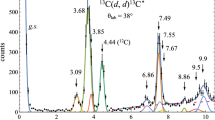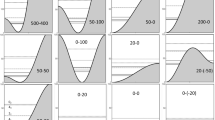Abstract
Two rotational bands are identified in \(^{119}\)Cs, one of which having very similar pattern to that of the strongly-coupled \(\pi g_{9/2}[404]9/2^+\) band. The properties of the bands with similar patterns extracted from the experimental data are in agreement with a chiral interpretation. Tilted axis cranking covariant density functional theory with pairing correlations and particle-number conserving cranked shell model calculations are employed to determine the deformation and to investigate the band configurations, respectively. It results that the backbending is induced by the rotational alignment of two \(h_{11/2}\) protons, whose angular momenta reorient from the short to the intermediate axis, in a plane orthogonal to the angular momentum of the strongly-coupled \(g_{9/2}\) proton which keeps aligned along the long axis. The total spin points in 3D, inducing the breaking of the chiral symmetry. This is the first observation of candidate chiral bands built on a configuration with three protons, one in the strongly coupled \([404]9/2^+\) orbital which does not change orientation with increasing rotational frequency, and two in the \(h_{11/2}\) orbital which reorients to the rotation axis. The bands are observed in the transient backbending regime, showing that the chirality in nuclei is a general phenomenon, being robust and present not only in nuclei with nearly maximal triaxiality and pure configurations, but also in nuclei with moderate triaxiality and mixed configurations which gradually evolve from one to three-quasiparticle configurations, like in the backbending region.











Similar content being viewed by others
Data Availability Statement
This manuscript has no associated data or the data will not be deposited. [Authors’ comment: No further data are associated with this paper.]
References
S. Frauendorf, J. Meng, Nucl. Phys. A 617, 131 (1997)
V.I. Dimitrov, S. Frauendorf, F. Dönau, Phys. Rev. Lett. 84, 5732 (2000)
S. Frauendorf, Rev. Mod. Phys. 73, 463 (2001)
B.W. Xiong, Y.Y. Wang, Atomic Data Nucl. Data Tables 111–112, 193 (2018)
S. Guo et al., Phys. Lett. B 807, 135572 (2020)
B.F. Lv et al., Phys. Rev. C 100, 024314 (2019)
C.M. Petrache et al., Eur. Phys. J. A 56, 208 (2020)
C.M. Petrache et al., Phys. Rev. C 97, 041304(R) (2018)
S. Zhu et al., Eur. Phys. J. A 25, 459 (2005)
S. Zhu et al., Phys. Lett. B 670, 307 (2009)
NNDC Online Data Service, ENSDF database, http://www.nndc.bnl.gov/ensdf/
J. Pakarinen et al., Eur. Phys. J. A 56, 149 (2020)
J. Sarén et al., Nucl. Instr. Meth. Phys. Res. A 266, 4196 (2008)
P. Rahkila, Nucl. Instrum. Meth. Phys. Res. A 595, 637 (2008)
D. Radford, Nucl. Instrum. Meth. Phys. Res. A 361, 297 (1995)
D. Radford, Nucl. Instrum. Meth. Phys. Res. A 361, 306 (1995)
V. Iacob, G. Duchêne, Nucl. Instr. Meth. Phys. Res. A 339(1), 57 (1997)
K. Starosta et al., Nucl. Instr. Meth. Phys. Res. A 423(1), 16 (1999)
K.K. Zheng et al., Phys. Rev. C 104, 044305 (2021)
F. Lidén et al., Nucl. Phys. A 550, 365 (1992)
P. Möller, R. Bengtsson, B.G. Carlsson, P. Olivius, T. Ichikawa, H. Sagawa, A. Iwamoto, Atomic Data Nucl. Data Tables 94, 758 (2008)
C. Thibault et al., Nucl. Phys. A 550, 365 (1992)
P.W. Zhao, S.Q. Zhang, J. Peng, H.Z. Liang, P. Ring, J. Meng, Phys. Lett. B 699, 181 (2011)
P.W. Zhao, J. Peng, S.Q. Zhang, P. Ring, J. Meng, Phys. Rev. Lett. 107, 122501 (2011)
P.W. Zhao, S.Q. Zhang, J. Meng, Phys. Rev. C 92, 034319 (2015)
Y.K. Wang, Phys. Rev. C 96, 054324 (2017)
Y.K. Wang, Phys. Rev. C 97, 064321 (2018)
P.W. Zhao, Z.P. Li, J.M. Yao, J. Meng, Phys. Rev. C 82, 054319 (2010)
Y. Tian, Y. Ma, P. Ring, Phys. Lett. B 676, 44 (2009)
J.Y. Zeng, T.H. Jin, Z.J. Zhao, Phys. Rev. C 50, 1388 (1994)
J.M. Sears et al., Phys. Rev. C 57, 2991 (1998)
Acknowledgements
The authors thank Prof. P. W. Zhao for stimulating and useful discussions. This work has been supported by the China Scholarship Council (CSC), CSC No. 201804910386. This work has been supported by the Academy of Finland under the Finnish Centre of Excellence Programme (2012-2017), by the EU 7th Framework Programme Project No. 262010 (ENSAR), by the United Kingdom Science and Technology Facilities Council, by the National Research Foundation of South Africa (Grants No. 116666 and No. 109134), and by the French Ministry of Foreign Affairs and the Ministry of Higher Education and Research, France (PHC PROTEA Grant No. 42417SE); by the National Research, Development and Innovation Fund of Hungary (Project No. K128947), as well as by the European Regional Development Fund (Contract No. GINOP-2.3.3-15-2016-00034); by the Polish National Science Centre (NCN) Grant No. 2013/10/M/ST2/00427; by the Swedish Research Council under Grant No. 2019-04880; and by the National Natural Science Foundation of China (Grants No. 11505242, No. 11305220, No. U1732139, No. 11775274, and No. 11575255). The use of germanium detectors from the GAMMAPOOL is acknowledged. I.K. was supported by National Research, Development and Innovation Office-NKFIH, contract number PD 124717.
Author information
Authors and Affiliations
Corresponding author
Additional information
Communicated by W. Korten.
Rights and permissions
About this article
Cite this article
Zheng, K.K., Petrache, C.M., Zhang, Z.H. et al. Candidate revolving chiral doublet bands in \({}^{119}\)Cs. Eur. Phys. J. A 58, 50 (2022). https://doi.org/10.1140/epja/s10050-022-00704-y
Received:
Accepted:
Published:
DOI: https://doi.org/10.1140/epja/s10050-022-00704-y




